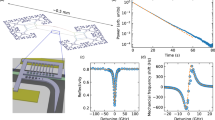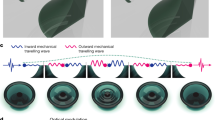Abstract
Recent table-top optical interferometry experiments1,2 and advances in gravitational-wave detectors3 have demonstrated the capability of optical interferometry to detect displacements with high sensitivity. Operation at higher powers will be crucial for further sensitivity enhancement, but dynamical effects caused by radiation pressure on the interferometer mirrors must be taken into account, and the appearance of optomechanical instabilities may jeopardize the stable operation of the next generation of interferometers4,5,6. These instabilities7,8 are the result of a nonlinear coupling between the motion of the mirrors and the optical field, which modifies the effective dynamics of the mirror. Such ‘optical spring’ effects have already been demonstrated for the mechanical damping of an electromagnetic waveguide with a moving wall9, the resonance frequency of a specially designed flexure oscillator10, and the optomechanical instability of a silica microtoroidal resonator11. Here we present an experiment where a micromechanical resonator is used as a mirror in a very high-finesse optical cavity, and its displacements are monitored with unprecedented sensitivity. By detuning the laser frequency with respect to the cavity resonance, we have observed a drastic cooling of the microresonator by intracavity radiation pressure, down to an effective temperature of 10 kelvin. For opposite detuning, efficient heating is observed, as well as a radiation-pressure-induced instability of the resonator. Further experimental progress and cryogenic operation may lead to the experimental observation of the quantum ground state of a micromechanical resonator12,13,14, either by passive15 or active cooling techniques16,17,18.
This is a preview of subscription content, access via your institution
Access options
Subscribe to this journal
Receive 51 print issues and online access
$199.00 per year
only $3.90 per issue
Buy this article
- Purchase on Springer Link
- Instant access to full article PDF
Prices may be subject to local taxes which are calculated during checkout




Similar content being viewed by others
References
Rugar, D., Budakian, R., Mamin, H. J. & Chui, B. W. Single spin detection by magnetic resonance force microscopy. Nature 430, 329–332 (2004)
Hadjar, Y., Cohadon, P-F., Aminoff, C. G., Pinard, M. & Heidmann, A. High-sensitivity measurement of mechanical Brownian motion. Europhys. Lett. 47, 545–551 (1999)
Abbott, B. et al. Upper limits on a stochastic background of gravitational waves. Phys. Rev. Lett. 95, 221101 (2005)
Meers, B. Recycling in laser-interferometric gravitational-wave detectors. Phys. Rev. D 38, 2317–2326 (1988)
Heinzel, G. et al. Experimental demonstration of a suspended dual recycling interferometer for gravitational wave detection. Phys. Rev. Lett. 81, 5493–5496 (1998)
Arcizet, O., Briant, T., Heidmann, A. & Pinard, M. Beating quantum limits in an optomechanical sensor by cavity detuning. Phys. Rev. A 73, 033819 (2006)
Pai, A., Dhurandar, S., Hello, P. & Vinet, J-Y. Radiation pressure induced instabilities in laser interferometric detectors of gravitational waves. Eur. Phys. J. D 8, 333–346 (2000)
Zhao, C., Ju, L., Degallaix, J. & Blair, D. Parametric instabilities and their control in advanced interferometer gravitational-wave detectors. Phys. Rev. Lett. 94, 121102 (2004)
Braginsky, V. B., Manukin, A. B. & Tikhonov, M. Yu. Investigation of dissipative ponderomotive effects of electromagnetic radiation. Sov. Phys. JETP 31, 829–830 (1970)
Sheard, B. S., Gray, M. B., Mow-Lowry, C. M., McClelland, D. E. & Whitcomb, S. E. Observation and characterization of an optical spring. Phys. Rev. A 69, 051801 (2004)
Kippenberg, T. et al. Analysis of radiation-pressure induced mechanical oscillation of an optical microcavity. Phys. Rev. Lett. 95, 033901 (2005)
Huang, X. M. H., Zorman, C. A., Mehregany, M. & Roukes, M. L. Nanoelectromechanical systems: Nanodevice motion at microwave frequencies. Nature 421, 496 (2003)
Knobel, R. G. & Cleland, A. N. Nanometre-scale displacement sensing using a single electron transistor. Nature 424, 291–293 (2003)
LaHaye, M. D., Buu, O., Camarota, B. & Schwab, K. C. Approaching the quantum limit of a nanomechanical resonator. Science 304, 74–77 (2004)
Hohberger Metzger, C. & Karrai, K. Cavity cooling of a microlever. Nature 432, 1002–1005 (2004)
Cohadon, P.-F., Heidmann, A. & Pinard, M. Cooling of a mirror by radiation pressure. Phys. Rev. Lett. 83, 3174–3177 (1999)
Arcizet, O. et al. High-sensitivity optical monitoring of a micro-mechanical resonator with a quantum-limited optomechanical sensor. Phys. Rev. Lett. 97, 133601 (2006)
Cohadon, P.-F., Arcizet, O., Briant, T., Heidmann, A. & Pinard, M. Optical monitoring and cooling of a micro-mechanical oscillator to the quantum limit. Proc. SPIE 5846, 124–134 (2005)
Dorsel, A., McCullen, J. D., Meystre, P., Vignes, E. & Walther, H. Optical bistability and mirror confinement induced by radiation pressure. Phys. Rev. Lett. 51, 1550–1553 (1983)
Kubo, R. The fluctuation-dissipation theorem. Rep. Prog. Phys. 29, 255–284 (1966)
Caves, C. M. Quantum-mechanical noise in an interferometer. Phys. Rev. D 23, 1693–1708 (1981)
Jaekel, M. T. & Reynaud, S. Quantum limits in interferometric measurements. Europhys. Lett. 13, 301–306 (1990)
Fabre, C. et al. Quantum-noise reduction using a cavity with a movable mirror. Phys. Rev. A 49, 1337–1343 (1994)
Heidmann, A., Hadjar, Y. & Pinard, M. Quantum nondemolition measurement by optomechanical coupling. Appl. Phys. B 64, 173–180 (1997)
Bose, S., Jacobs, K. & Knight, P. L. Preparation of nonclassical states in cavities with a moving mirror. Phys. Rev. A 56, 4175–4186 (1997)
Pinard, M. et al. Entangling movable mirrors in a double-cavity system. Europhys. Lett. 72, 747–753 (2005)
Acknowledgements
We are grateful to L. Rousseau for the fabrication of the microresonator and to J.-M. Mackowski and his group for the optical coating of the resonator. This work was partially funded by EGO (collaboration convention for a study of quantum noises in gravitational-wave interferometers). Laboratoire Kastler Brossel is a research unit of Ecole Normale Supérieure and Université Paris 6, associated with CNRS.
Author information
Authors and Affiliations
Corresponding author
Ethics declarations
Competing interests
Reprints and permissions information is available at www.nature.com/reprints. The authors declare no competing financial interests.
Supplementary information
Supplementary Notes
This file contains details on the mechanical resonator and optical sensing methods. (PDF 89 kb)
Rights and permissions
About this article
Cite this article
Arcizet, O., Cohadon, PF., Briant, T. et al. Radiation-pressure cooling and optomechanical instability of a micromirror. Nature 444, 71–74 (2006). https://doi.org/10.1038/nature05244
Received:
Accepted:
Issue Date:
DOI: https://doi.org/10.1038/nature05244
This article is cited by
-
Effect of atomic ensemble position on the dynamics of cold atoms in an optical cavity: normal-mode splitting
Indian Journal of Physics (2024)
-
Study of optical bistability/multistability and transparency in cavity-assisted-hybrid optomechanical system embedded with quantum dot molecules
Optical and Quantum Electronics (2024)
-
Entanglement-enhanced optomechanical sensing
Nature Photonics (2023)
-
Microwave Optomechanically Induced Transparency and Absorption Between 250 and 450 mK
Journal of Low Temperature Physics (2023)
-
Perfect optomechanically induced transparency in two-cavity optomechanics
Frontiers of Physics (2023)
Comments
By submitting a comment you agree to abide by our Terms and Community Guidelines. If you find something abusive or that does not comply with our terms or guidelines please flag it as inappropriate.



